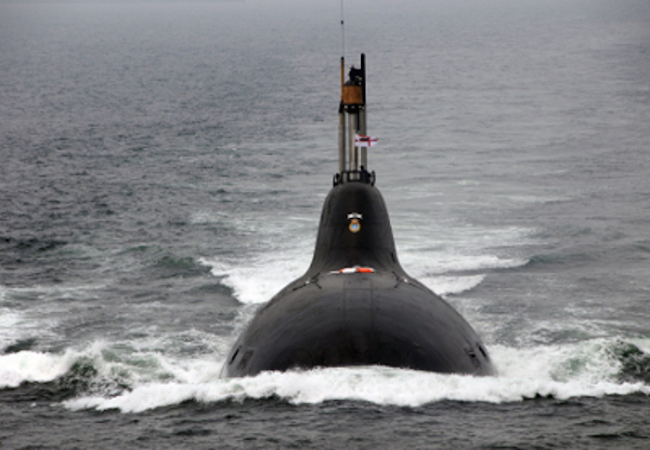
By Maimuna Ashraf
Among many other prevailing challenges, South Asian regional security has been newly challenged by the recent secret test of India’s submarine-launched ballistic missile (SLBM) K-4. The test has boosted Indian deterrence capabilities, but disturbed strategic balance in the already murky regional landscape by creating a security dilemma for Pakistan. The academic world has been buzzing with criticism since reports emerged that India’s first nuclear-powered submarine, INS Arihant, is ready to be commissioned into operational service after completing weapons trials and deep-sea diving drills. This addition creates two immediate consequences: first, it is likely to provide India a seaborne nuclear deterrent, despite certain attributes of Arihant that are believed to limit its operational role, and skepticism about the success rate of missiles tested from this submarine. Second, it will elevate India’s rivalry with China and Pakistan in the maritime domain.
The ocean has thus become the hub of competition between the key regional powers. As U.S. Rear Admiral Alfred Thayer Mahan said presciently at the turn of the 20th century: “Whoever controls the Indian Ocean will dominate Asia… This ocean is the key to the seven seas in the twenty-first century, the destiny of the world will be decided in these waters.” Oceans now have a more significant role in South Asian strategy than ever before. The security challenges in the Indian Ocean Region (IOR) have magnified in the wake of economic sea trade routes that connect Europe and the Americas to Africa, the Middle East, and the Asian continent, significant strategic chokepoints through which more than half of the world’s sea-based oil trade moves, and a rising rivalry between India and China. Around 85 percent of China’s oil imports pass through the Strait of Malacca. Whereas India, with its hegemonic ambitions in the region, wants to keep its traditional influence in this ocean. Meanwhile, the United States already has a naval presence there.
Nuclear weapons are the most recent aspect of this strategic contest, thus the strategic significance is not confined to economic worth or conventional military influence. In the current milieu, four nuclear states have strategic interests in the region, and the waters of the Indian Ocean are witnessing three separate contests for regional influence: between the United States and China, China and India, and India and Pakistan. These rivalries are making the existing environment in the region highly unstable. The United States-India nuclear deal and their growing strategic partnership is largely viewed as an alliance to counter China and Pakistan. Conversely, India is skeptical about the Chinese claim that the “string of pearls” strategy aims to provide alternative sea trade routes, and New Delhi suspects that it is an effort to militarize or even nuclearize the region. The launch of India’s INS Arihant should not worry China, even if it indicates New Delhi’s aspiration to nuclearize its navy, because China already has advanced nuclear capabilities. Nonetheless, it disturbs the deterrence equation in an already unstable South Asia.
In the same vein, technically, Pakistan should not react if an Indian nuclear submarine is aimed at deterring China. However, this sea-based nuclear deterrent raises fears of Pakistan’s destruction by a state possessing superior capabilities. Just as India is compelled to respond to Chinese sea-based nuclear developments, so is Pakistan to India’s.
Nuclear optimists believe that a diversified nuclear force structure, covering each leg of the nuclear triad, assures credible second-strike capability, thus decreasing susceptibility to a nuclear attack and stabilizing a nuclear relationship. Notwithstanding the aforesaid optimistic rationale about sea-based deterrence, nuclear rivalry in the maritime realm can create greater instability and many criticsare skeptical about the notion that sea-based nuclear arsenals can act as a stabilizer in the region. In the next few years, most of the sea-based nuclear weapons in the region, primarily Indian and Chinese, may move from the design and testing phase to active deployment. As Rory Medcalf notes: “The implications of new sea-based nuclear weapons for deterrence, stability or instability will not be determined by those weapons systems alone. Investment in other capabilities like ballistic missile defenses, anti-submarine warfare (including nuclear-powered attack submarines) and hypersonic missiles could complicate the picture.” Anti-submarine warfare capability is something the United States might assist India with. Such sea-based nuclear cooperation will fuel Pakistan’s naval nuclear ambitions. Pakistan may look to neutralize developments in India by deploying submarine-launched variants of cruise missiles on a conventional submarine. The ambiguous combination of conventional and nuclear capabilities at sea would result in an additional challenge.
India and Pakistan should abide by the agreement on pre-notification of flight testing of ballistic missile, reached between the two states in 2005, which the K-4 test violated. Such infringements and negligence can cause many regional security risks, including nuclear accidents and miscalculations. Ideally, the security of the Indian Ocean should be a matter of concern for all states sharing economic and strategic interests in the region, including the United States and other actors not within the region. While states in the Indo-Pacific region are developing their nuclear submarine programs, vital matters regarding command and control, future posture, and notification of missile tests should be addressed through bilateral and multilateral channels to avoid mistrust, miscommunication, and misconception.




